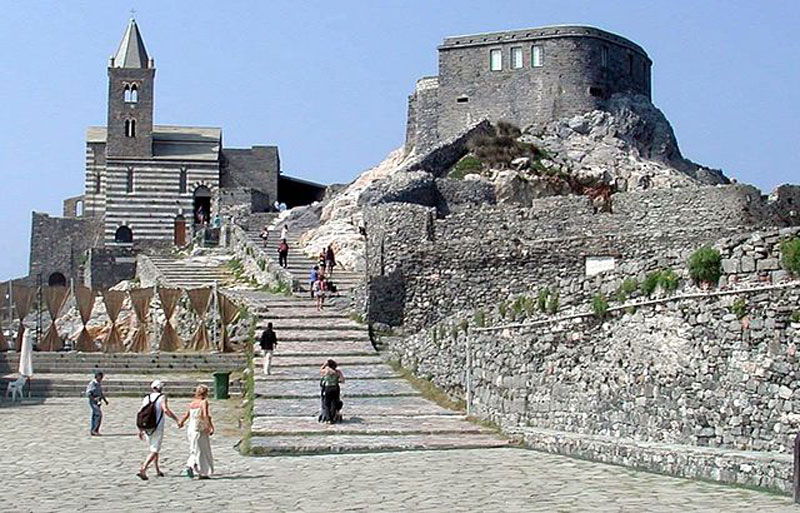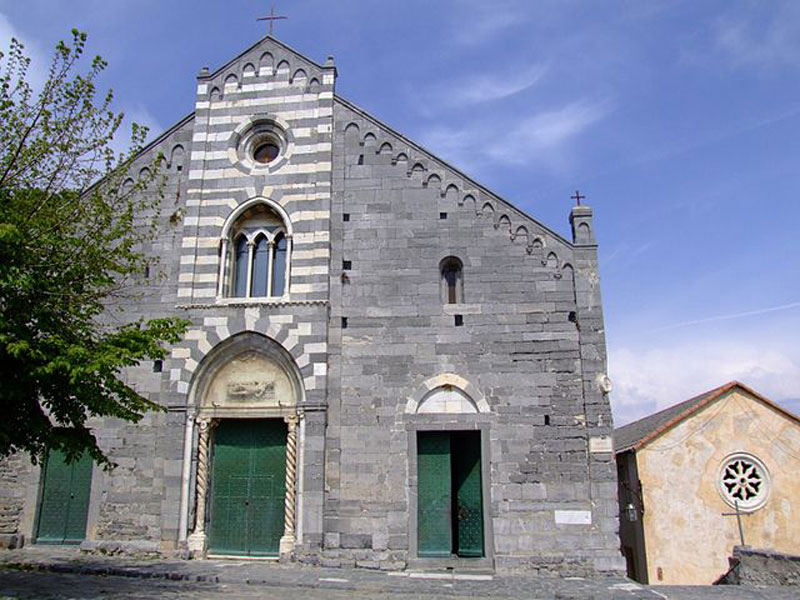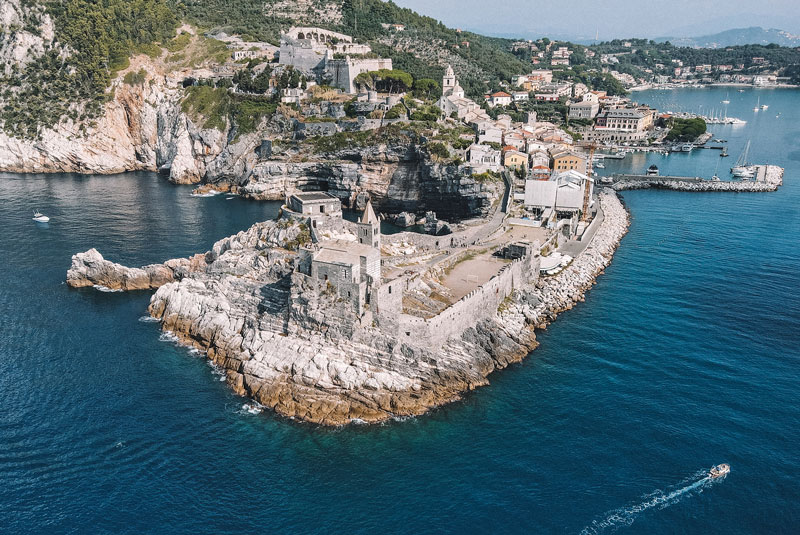You might want to consider traveling beyond Cinque Terre and continue a few miles further south of Riomaggiore for a bonus -- Portovenere, sometimes called the sixth village, yet another beautiful seaside town you do not want to miss!
The most practical way to get to Portovenere from Cinque Terre is with a 35-minute ferry ride, since there is no train service, and the hiking trail from Riomaggiore is seven miles long. If you were to go by train and bus it would take about 90 minutes, with a connection in La Spezia. You could also go by taxi in 30 minutes, for about 40 euro.

The ferry takes another picturesque cruise along the shore then arrives at the ultra-picturesque little harbor, dotted with small craft at anchor and framed by a picturesque row of pastel-colored facades lining the waterfront.

Portovenere had been a fortress back in the old days, as were all of these towns, but here you can still see the fort up on the hill and a sizeable medieval wall that comes down the slope with guard towers and gates to protect it. That row of waterfront houses also functioned as part of the wall that encircled this fortified compound to protect its inhabitants from rampaging Saracens, pirates and various other invaders from over the years.
.jpg)
There is small sandy beach in the town center facing the fishing fleet that brings in the daily catch to supply all the restaurants along the ocean-front promenade. People prefer to sunbathe on the rocks rather than the beach for some reason, making themselves comfortable sprawling by the water’s edge, soaking up that Mediterranean sun.
Of course, just strolling about is one of the main activities. There is no need for strenuous hiking here, but certainly, a short walk through the village is most enjoyable.
.jpg)
Walk through circular Piazza Bastreri, near the beach and taxi stand along the waterfront, and stride through a large stone gate in the wall of this fortified, medieval town and enter Via Giovanni Capellini, the main lane of town lined with shops, apartments and attractive places to eat.
.jpg)
There is a small network here of narrow, curved lanes that make you wonder what’s around the bend, luring you deeper to discover what’s next.
.jpg)
We happened upon a dozen cats perched, Italian style, on two scooters waiting for their lunch to be served. Typical of local scenes you will invariably encounter.
.jpg)
Oh, the foods! Seafood, of course, is the main dish to enjoy in this little harbor village, where you can pick from a row of outdoor restaurants with dining terraces overlooking the marina, filled with fishing boats that just supplied your dinner. Or, you could just get take-out foods if you’d rather have a picnic at one of the nearby scenic spots along the shore.
.jpg)
Visit one of the aromatic food shops featuring a wide variety of locally-grown olives, hunks of cheese, pizza, focaccia, fresh breads, fruits, and bottles of local wine found nowhere else, to create a meal that celebrates your memorable visit.

Church of St. Peter
The Church of St. Peter, consecrated in 1198. It was built over a pre-existing 5th-century Palaeo-Christian church, which had rectangular plan and semicircular apse. The new part, from the 13th century, is marked externally by white and black stripes.

The Romanesque Church of St. Lawrence, erected in 1098 by the Genoese probably occupies the site of ancient temple dedicated to Jupiter. The church was damaged by a fire in 1340 and by the Aragonese attack in 1494, and was further restored in 1582.
The Doria Castle, an example of Genoese military architecture. The castle has changed over the centuries in response to developments in military technology. The castle consists of two parts, a 15th Century upper section and a later (post-cannon) lower section. The lower section contains the Sala Ipostila, a hall built on the site of ancient Greek temples.

The upper section contains the Casa del Catellano, the home of the commander of the castle and sits above the Sala Ipostila. During the Napoleonic period after 1807, the Castle saw service as a political prison.
The Grotta dell'Arpaia (now collapsed), known as Byron's Grotto, from which the English poet Byron swam across the gulf of La Spezia to San Terenzo to visit Shelley in Lerici, in 1822.
History
The ancient Portus Veneris is believed to date back to at least the middle of the 1st century BC. It has been said that the name refers to a temple to the goddess Venus which was sited on the promontory where the church of Peter the Apostle now stands. The name has also been linked to that of the hermit Saint Venerius. In Roman times the city was essentially a fishing community.
After the fall of the Western Roman Empire, Porto Venere became the base of the Byzantine fleet in the northern Tyrrhenian Sea, but was destroyed by the Lombards in 643 AD. Later, it was a frequent target of Saracen raids. First indications of the existence of a castle date from 1113, and in 1161 the walls were erected. Porto Venere became a fiefdom of a family from Vezzano before passing to Republic of Genoa in the early 12th century. In 1494, it suffered a devastating bombardment from the Aragonese fleet during their war with Genoa: subsequently the old part of the town declined in importance, giving way to the development of the Borgo Nuovo ("New District"), which had existed from 1139 and is centred on the church of St. Peter.
On 2 December 1797, after the French established their domination in Italy, the town became part of the Department of the Gulf of Venus, with the capital in La Spezia, in the Ligurian Republic annexed to the First French Empire. From 28 April 1798 with the new French law, the territory of Portovenere fell in the seventh canton, as the capital, the Jurisdiction of the Gulf of Venus since 1803 and the main center of the third State of the Gulf of Venus in the jurisdiction of the Gulf of Venus. From 13 June 1805 to 1814 it was included in the Department of the Apennines. It was at this point which, in 1812, it became part of the coastal route called "Route Napoleon" in honor of the French general and now known as localized road 530, which still connects the marine center with La Spezia via Fezzano, Le Grazie and Terizzo.
In 1815 it was incorporated in the Kingdom of Sardinia, according to the decisions of the Congress of Wien of 1814, and subsequently in the Kingdom of Italy from 1861. From 1859 to 1927 the territory was included in the First district of La Spezia, part of the Eastern District of the Province of Genoa before and, with its establishment in 1923, the Province of La Spezia.
In 1998 it obtained for its architectural heritage and natural entry in the list of protected World Heritage Site,
When finished with Portovenere, there is a direct boat back to Manarola, one hour away.
On board you could mingle a bit with locals and other tourists, most of whom are Europeans, usually Italians or Germans out for a day’s hiking adventure. Interacting with these other tourists is part of the fun as you cruise past all the villages you have just explored, providing a scenic, relaxing recap of your journey.
Watch the same video on the dedicated video page.